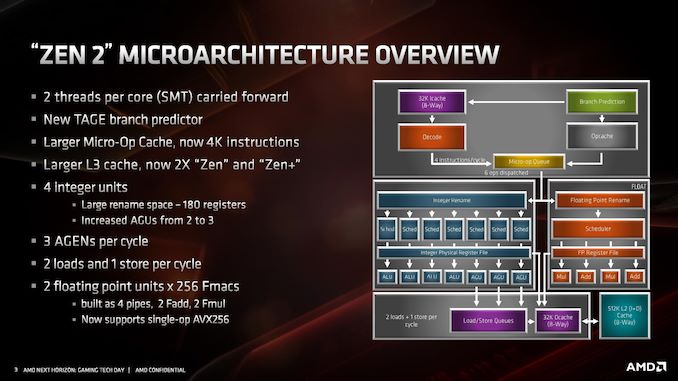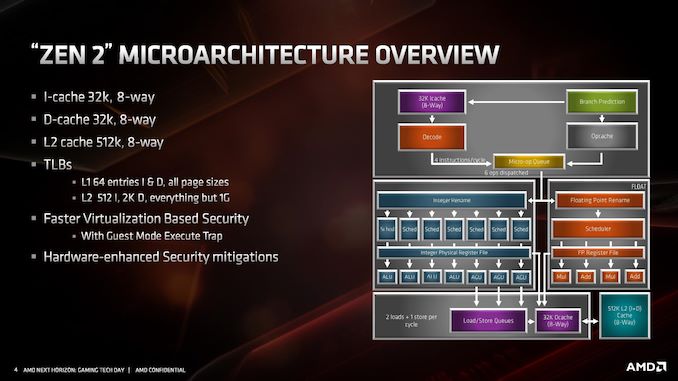AMD Zen 2 Microarchitecture Analysis: Ryzen 3000 and EPYC Rome
by Dr. Ian Cutress on June 10, 2019 7:22 PM EST- Posted in
- CPUs
- AMD
- Ryzen
- EPYC
- Infinity Fabric
- PCIe 4.0
- Zen 2
- Rome
- Ryzen 3000
- Ryzen 3rd Gen
AMD Zen 2 Microarchitecture Overview
The Quick Analysis
At AMD’s Tech Day, on hand was Fellow and Chief Architect Mike Clark to go through the changes. Mike is a great engineer to talk to, although what always amuses me (for any company, not just AMD) is that engineers that talk about the latest products coming to market are already working one, two, or three generations ahead at the company. Mike remarked that it took him a while to think back to the specific Zen+ to Zen 2 changes, while his mind internally is already several generations down the line.
An interesting element to Zen 2 is around the intention. Initially Zen 2 was merely going to be a die shrink of Zen+, going from 12nm down to 7nm, similar to what we used to see with Intel in its tick-tock model for the initial part of the century. However, based on internal analysis and the time frame for 7nm, it was decided that Zen 2 would be used as a platform for better performance, taking advantage of 7nm in multiple ways rather than just redesigning the same layout on a new process node. As a result of the adjustments, AMD is promoting a +15% IPC improvement for Zen 2 over Zen+.
When it comes down to the exact changes in the microarchitecture, what we’re fundamentally looking at is still a similar floorplan to what Zen looks like. Zen 2 is a family member of the Zen family, and not a complete redesign or different paradigm on how to process x86 – as will other architectures that have familial updates, Zen 2 affords a more efficient core and a wider core, allowing better instruction throughput.
At a high level, the core looks very much the same. Highlights of the Zen 2 design include a different L2 branch predictor known as a TAGE predictor, a doubling of the micro-op cache, a doubling of the L3 cache, an increase in integer resources, an increase in load/store resources, and support for single-operation AVX-256 (or AVX2). AMD has stated that there is no frequency penalty for AVX2, based on its energy aware frequency platform.
AMD has also made adjustments to the cache system, the most notable being for the L1 instruction cache, which has been halved to 32 kB, but associativity has doubled. This change was made for important reasons, which we’ll go into over the next pages. The L1 data cache and L2 caches are unchanged, however the translation lookaside buffers (TLBs) have increased support. AMD also states that it has added deeper virtualization support with respect to security, helping enable features further down the pipeline. As mentioned previously in this article, there are also security hardening updates.
For the quick analysis, it’s easy to tell that doubling the micro-op cache is going to offer a significant improvement to IPC in a number of scenarios, and combine that with an increase in load/store resources is going to help more instructions get pushed through. The double L3 cache is going to help in specific workloads, as would the AVX2 single-op support, but the improved branch predictor is also going to showcase raw performance uplift. All-in-all, for an on-paper analysis, AMD’s +15% IPC improvement seems like a very reasonable number to promote.
Over the next few pages, we’ll go deeper into how the microarchitecture has changed.












216 Comments
View All Comments
Korguz - Monday, June 17, 2019 - link
im glad im not the only one that sees this...Qasar - Monday, June 17, 2019 - link
korguz, you aren't the only one that sees it.Xyler94, i dont hate intel.. but i am sick of what they have done so far to the cpu industry, sticking the mainstream with quad cores for how many years ? i would of loved to get a 6 or 8 core intel chip, but the cost of the platform, made it out of my reach. the little performance gains year over year, come on, thats the best intel can do with all the money they have ?? and the constant lies about 10nm.... then Zen is released and what was it, less then 2 months later, intel all of a sudden has more then 4 cores for the mainstream, and even more cores for the HEDT ? my next upgrade at this point, looks to be zen 2.. but i am waiting till the 7th, to read the reviews. hstewart does glorify intel any chance he can, and it just looks so stupid, cause some one calls him out on it.. and he seems to pretty much vanish from that convo
HStewart - Thursday, June 13, 2019 - link
Notice that I mention unless they change it from dual 128 bit.Targon - Thursday, June 13, 2019 - link
Socket AM4 is limited to a dual-channel memory controller, because you need more pins to add more memory channels. The same applies to the number of PCI Express lanes as well. The only way around this would be to use one of the abilities of Gen-Z where the CPU would just talk to the Gen-Z bus, at which point, dedicated pins for memory and PCI Express could be replaced by a very wide and fast connection to the system bus/fabric. Since that would require a new motherboard and for the CPU to be designed around it, why bother with socket AM4 at that point?Korguz - Thursday, June 13, 2019 - link
why bother?? um upgrade ability ? maybe not quite needed ? the things you suggest, sound like they would be a little expensive to implement. if you need more memory bandwidth and pcie lanes.. grab a TR board and a lower end cpu....austinsguitar - Monday, June 10, 2019 - link
Thank you Ian for this write up. :)megapleb - Monday, June 10, 2019 - link
Why does the 3600X have power consumption of 95W, and the 3700X, with two more cores, four more threads, and the same frequency max, consume only 65W? I'm guessing those two got switched around?anonomouse - Monday, June 10, 2019 - link
higher sustained base clock drives up the tdpmegapleb - Monday, June 10, 2019 - link
200Mhz extra base increases power consumption by 46%? I would have though max power consumption would be all cores operating at maximum frequency so the base would have nothing to do with it?scineram - Tuesday, June 11, 2019 - link
Nobody said anything about power consumption.